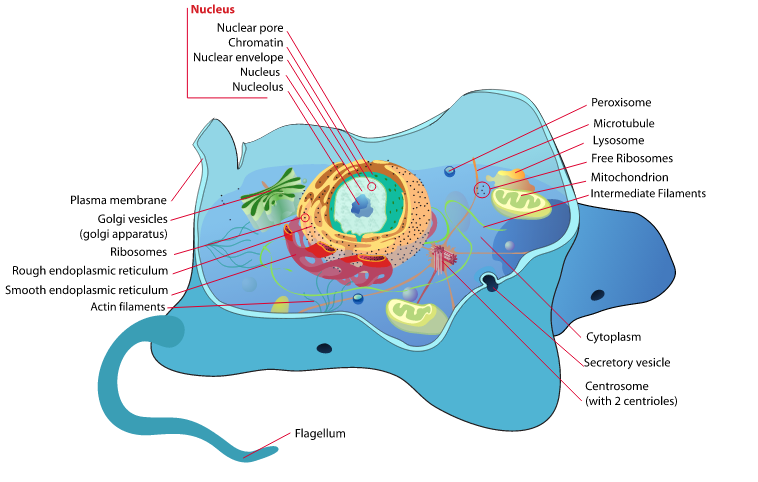The nucleoid is a distinct region within bacterial cells where the genetic material, DNA, is located. Unlike eukaryotic cells, bacteria do not have a membrane-bound nucleus. Instead, their DNA is organized and compacted within the nucleoid. The nucleoid plays a crucial role in bacterial physiology as it houses the genetic information necessary for cell growth, division, and survival.
The nucleoid is essential for bacterial cells as it contains all the genetic instructions required for their survival and reproduction. It serves as the control center for gene expression, regulating the synthesis of proteins and other molecules necessary for cellular processes. The nucleoid also plays a role in DNA replication and repair, ensuring the accurate transmission of genetic information to daughter cells during cell division.
Key Takeaways
- The nucleoid is the region in bacteria where the genetic material is located.
- The nucleoid is not enclosed by a membrane and is composed of DNA, RNA, and proteins.
- Nucleoid proteins play a crucial role in DNA compaction and regulation.
- The interactions between nucleoid proteins and DNA are essential for proper DNA replication and transcription.
- Environmental factors can affect nucleoid organization and function, making it a potential target for antibacterial drug development.
Anatomy and Structure of the Nucleoid
The size and shape of the nucleoid can vary depending on the bacterial species and growth conditions. In general, the nucleoid is compacted into a dense mass within the bacterial cell. It is typically located near the center of the cell, although its exact position can vary.
The composition of the nucleoid primarily consists of DNA, which is tightly packed and organized within the cell. The DNA in bacteria is circular and forms a single chromosome. In addition to DNA, the nucleoid also contains various proteins that help in DNA compaction and organization.
When comparing the nucleoid to the nucleus in eukaryotic cells, there are several key differences. The nucleus is surrounded by a nuclear envelope, which separates it from the rest of the cell. It also contains multiple chromosomes, whereas bacteria have a single circular chromosome. Additionally, eukaryotic cells have specialized structures called histones that help in DNA packaging, whereas bacteria use different mechanisms for DNA compaction.
DNA Packaging and Organization in the Nucleoid
One of the key features of the nucleoid is the supercoiling of DNA. Bacterial DNA is highly compacted through the twisting and coiling of the DNA molecule upon itself. This supercoiling allows for efficient packaging of the DNA within the limited space of the bacterial cell.
Histone-like proteins play a crucial role in DNA compaction in bacteria. These proteins bind to the DNA and help in organizing it into a more condensed structure. While they are not true histones like those found in eukaryotic cells, they perform similar functions in DNA packaging.
The organization of DNA within the nucleoid is not random but rather forms distinct domains. These domains are thought to play a role in regulating gene expression by bringing together specific genes that need to be co-regulated. The organization of these domains is dynamic and can change depending on the growth phase and environmental conditions.
Role of Nucleoid Proteins in DNA Compaction and Regulation
| Role of Nucleoid Proteins in DNA Compaction and Regulation | |||
|---|---|---|---|
| Protein Name | Function | Effect on DNA Compaction | Effect on Gene Regulation |
| HU | Binds to DNA and induces bending | Increases compaction | Regulates gene expression by promoting or inhibiting transcription |
| H-NS | Binds to DNA and induces bending | Increases compaction | Represses transcription of genes involved in virulence and stress response |
| Integration Host Factor (IHF) | Binds to DNA and induces bending | Increases compaction | Regulates gene expression by promoting or inhibiting transcription |
| Condensin | Forms a ring around DNA and induces supercoiling | Increases compaction | Regulates gene expression by promoting or inhibiting transcription |
| Topoisomerase | Relaxes supercoiled DNA | Decreases compaction | Regulates gene expression by promoting or inhibiting transcription |
Nucleoid-associated proteins (NAPs) are a group of proteins that play a crucial role in DNA compaction and organization within the nucleoid. These proteins bind to the DNA and help in forming higher-order structures that facilitate DNA packaging.
NAPs have multiple functions within the nucleoid. They not only aid in DNA compaction but also play a role in regulating gene expression. By binding to specific regions of the DNA, NAPs can either promote or inhibit gene transcription, thereby controlling which genes are expressed at any given time.
The regulation of gene expression by NAPs is essential for bacterial cells to respond to changes in their environment. By controlling which genes are expressed, bacteria can adapt to different conditions and ensure their survival. NAPs also play a role in DNA repair and recombination, further highlighting their importance in bacterial physiology.
Nucleoid Proteins and their Interactions with DNA
The interactions between NAPs and DNA are complex and can vary depending on the specific protein and DNA sequence involved. NAPs can bind to DNA in a sequence-specific or non-specific manner. Some NAPs have a preference for binding to specific DNA sequences, while others can bind to any DNA region.
The specificity of NAP-DNA binding is crucial for their function in gene regulation. By binding to specific regions of the DNA, NAPs can either promote or inhibit the binding of RNA polymerase, the enzyme responsible for gene transcription. This allows bacteria to fine-tune gene expression and respond to changes in their environment.
The interactions between NAPs and DNA also play a role in determining the accessibility of the DNA. By binding to specific regions, NAPs can either open up or close off certain areas of the DNA, making them more or less accessible to other proteins involved in DNA replication, repair, and transcription.
Mechanisms of DNA Replication and Transcription in the Nucleoid

DNA replication and transcription are essential processes for bacterial cells to replicate and express their genetic information. However, the compacted nature of the nucleoid poses challenges for these processes.
During DNA replication, the DNA molecule needs to be unwound and separated into two strands so that each strand can serve as a template for the synthesis of a new DNA molecule. The supercoiling of DNA within the nucleoid makes this process more challenging. Bacteria have evolved mechanisms to overcome this challenge, including the action of specific enzymes that can relax supercoiled DNA.
Transcription, on the other hand, involves the synthesis of RNA molecules from a DNA template. The compacted nature of the nucleoid can hinder the access of RNA polymerase to specific genes. However, NAPs play a role in regulating gene expression by either promoting or inhibiting the binding of RNA polymerase. This allows bacteria to control which genes are transcribed and when.
Nucleoid Dynamics and its Impact on Bacterial Physiology
The organization of the nucleoid is not static but rather dynamic and can change during the cell cycle and in response to environmental cues. During cell division, the nucleoid needs to be accurately segregated into daughter cells. This process involves the coordinated action of proteins that help in separating and partitioning the nucleoid.
The organization of the nucleoid can also impact bacterial physiology. Changes in nucleoid organization have been linked to changes in gene expression and cellular processes. For example, changes in nucleoid organization have been observed during bacterial stress responses and in response to changes in growth conditions.
The relationship between nucleoid organization and bacterial pathogenesis is an area of active research. It is thought that changes in nucleoid organization can impact the expression of virulence factors, which are molecules that allow bacteria to cause disease. Understanding how nucleoid organization influences bacterial pathogenesis could lead to new strategies for combating bacterial infections.
Environmental Factors Affecting Nucleoid Organization and Function
The organization and function of the nucleoid can be influenced by various environmental factors. Changes in temperature, pH, nutrient availability, and other factors can impact nucleoid organization and gene expression.
For example, changes in temperature can affect the supercoiling of DNA within the nucleoid. High temperatures can lead to increased DNA supercoiling, which can impact gene expression. Similarly, changes in nutrient availability can alter the expression of NAPs, leading to changes in nucleoid organization.
Understanding how environmental factors affect nucleoid organization and function is crucial for understanding bacterial adaptation and survival. Bacteria need to be able to respond to changes in their environment to ensure their survival and reproduction.
Nucleoid as a Target for Antibacterial Drug Development
Antibacterial drug development has traditionally focused on targeting specific bacterial proteins or processes involved in cell growth and division. However, targeting the nucleoid could provide a new avenue for developing antibacterial drugs.
The nucleoid is essential for bacterial survival, and disrupting its organization and function could be detrimental to bacterial cells. By targeting proteins involved in nucleoid organization or DNA compaction, it may be possible to develop drugs that selectively kill bacterial cells while sparing human cells.
Several nucleoid-targeting antibacterial drugs have already been developed and are in use. These drugs work by interfering with the function of NAPs or enzymes involved in DNA replication and transcription. By targeting the nucleoid, these drugs can disrupt bacterial physiology and inhibit bacterial growth.
Future Directions in Nucleoid Research and Applications
Nucleoid research is a rapidly evolving field, and there are several emerging areas of interest. One area of research is understanding the role of specific NAPs in nucleoid organization and gene regulation. By studying the function of individual NAPs, researchers can gain insights into their specific roles and mechanisms of action.
Another area of interest is the potential applications of nucleoid research in biotechnology and medicine. Understanding how nucleoid organization impacts gene expression could have implications for gene therapy and genetic engineering. Additionally, targeting the nucleoid could provide new strategies for combating bacterial infections.
However, there are also challenges and opportunities in nucleoid research. The complex nature of nucleoid organization and the interactions between NAPs and DNA make it a challenging field to study. However, advances in imaging techniques and computational modeling are providing new tools for studying nucleoid organization and function.
In conclusion, the nucleoid is a crucial component of bacterial cells that plays a central role in their physiology. It houses the genetic information necessary for cell growth, division, and survival. The organization and function of the nucleoid are influenced by various factors, including environmental cues. Understanding how the nucleoid is organized and regulated could provide insights into bacterial adaptation and survival. Furthermore, targeting the nucleoid could provide new strategies for developing antibacterial drugs.
FAQs
What is a nucleoid?
A nucleoid is a region within a prokaryotic cell where the genetic material is located. It is not enclosed by a membrane, unlike the nucleus in eukaryotic cells.
What is the function of the nucleoid?
The nucleoid contains the genetic material of the cell, which is essential for the cell’s survival and reproduction. It is responsible for controlling the cell’s activities and passing on genetic information to the next generation of cells.
What is the structure of the nucleoid?
The nucleoid is a compact, irregularly shaped region within the cell that contains the DNA. It is not enclosed by a membrane, but is instead held together by proteins that help to organize and condense the DNA.
How is the nucleoid different from the nucleus?
The nucleoid is found in prokaryotic cells, while the nucleus is found in eukaryotic cells. The nucleoid is not enclosed by a membrane, while the nucleus is surrounded by a double membrane. Additionally, the nucleoid contains a single, circular chromosome, while the nucleus contains multiple linear chromosomes.
What types of cells have a nucleoid?
Only prokaryotic cells have a nucleoid. This includes bacteria and archaea.
What is the role of proteins in the nucleoid?
Proteins in the nucleoid help to organize and condense the DNA, making it more compact and easier to manage. They also play a role in regulating gene expression and controlling the cell’s activities.


